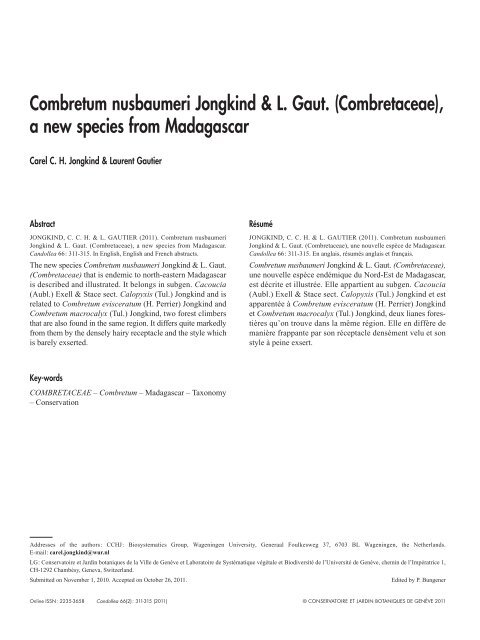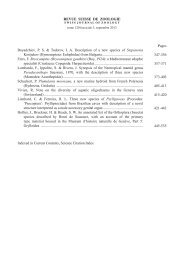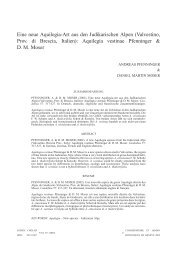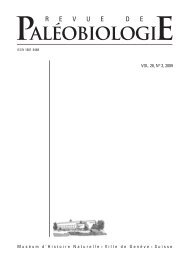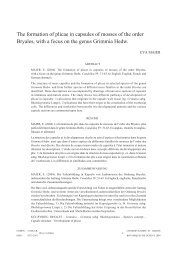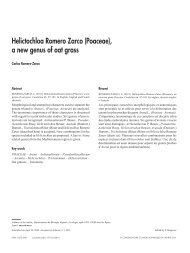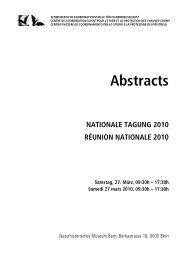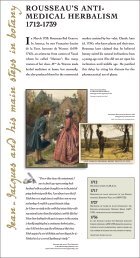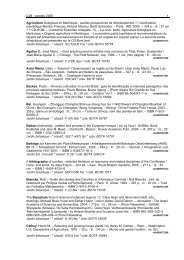Combretum nusbaumeri Jongkind & L. Gaut ... - Ville de Genève
Combretum nusbaumeri Jongkind & L. Gaut ... - Ville de Genève
Combretum nusbaumeri Jongkind & L. Gaut ... - Ville de Genève
Create successful ePaper yourself
Turn your PDF publications into a flip-book with our unique Google optimized e-Paper software.
<strong>Combretum</strong> <strong>nusbaumeri</strong> <strong>Jongkind</strong> & L. <strong>Gaut</strong>. (Combretaceae),<br />
a new species from Madagascar<br />
Carel C. H. <strong>Jongkind</strong> & Laurent <strong>Gaut</strong>ier<br />
Abstract<br />
JONGKIND, C. C. H. & L. GAUTIER (2011). <strong>Combretum</strong> <strong>nusbaumeri</strong><br />
<strong>Jongkind</strong> & L. <strong>Gaut</strong>. (Combretaceae), a new species from Madagascar.<br />
Candollea 66: 311-315. In English, English and French abstracts.<br />
The new species <strong>Combretum</strong> <strong>nusbaumeri</strong> <strong>Jongkind</strong> & L. <strong>Gaut</strong>.<br />
(Combretaceae) that is en<strong>de</strong>mic to north-eastern Madagascar<br />
is <strong>de</strong>scribed and illustrated. It belongs in subgen. Cacoucia<br />
(Aubl.) Exell & Stace sect. Calopyxis (Tul.) <strong>Jongkind</strong> and is<br />
related to <strong>Combretum</strong> evisceratum (H. Perrier) <strong>Jongkind</strong> and<br />
<strong>Combretum</strong> macrocalyx (Tul.) <strong>Jongkind</strong>, two forest climbers<br />
that are also found in the same region. It differs quite markedly<br />
from them by the <strong>de</strong>nsely hairy receptacle and the style which<br />
is barely exserted.<br />
Key-words<br />
COMBRETACEAE – <strong>Combretum</strong> – Madagascar – Taxonomy<br />
– Conservation<br />
Résumé<br />
JONGKIND, C. C. H. & L. GAUTIER (2011). <strong>Combretum</strong> <strong>nusbaumeri</strong><br />
<strong>Jongkind</strong> & L. <strong>Gaut</strong>. (Combretaceae), une nouvelle espèce <strong>de</strong> Madagascar.<br />
Candollea 66: 311-315. En anglais, résumés anglais et français.<br />
<strong>Combretum</strong> <strong>nusbaumeri</strong> <strong>Jongkind</strong> & L. <strong>Gaut</strong>. (Combretaceae),<br />
une nouvelle espèce endémique du Nord-Est <strong>de</strong> Madagascar,<br />
est décrite et illustrée. Elle appartient au subgen. Cacoucia<br />
(Aubl.) Exell & Stace sect. Calopyxis (Tul.) <strong>Jongkind</strong> et est<br />
apparentée à <strong>Combretum</strong> evisceratum (H. Perrier) <strong>Jongkind</strong><br />
et <strong>Combretum</strong> macrocalyx (Tul.) <strong>Jongkind</strong>, <strong>de</strong>ux lianes forestières<br />
qu’on trouve dans la même région. Elle en diffère <strong>de</strong><br />
manière frappante par son réceptacle <strong>de</strong>nsément velu et son<br />
style à peine exsert.<br />
Addresses of the authors: CCHJ: Biosystematics Group, Wageningen University, Generaal Foulkesweg 37, 6703 BL Wageningen, the Netherlands.<br />
E-mail: carel.jongkind@wur.nl<br />
LG: Conservatoire et Jardin botaniques <strong>de</strong> la <strong>Ville</strong> <strong>de</strong> <strong>Genève</strong> et Laboratoire <strong>de</strong> Systématique végétale et Biodiversité <strong>de</strong> l’Université <strong>de</strong> <strong>Genève</strong>, chemin <strong>de</strong> l’Impératrice 1,<br />
CH-1292 Chambésy, Geneva, Switzerland.<br />
Submitted on November 1, 2010. Accepted on October 26, 2011. Edited by P. Bungener<br />
Online ISSN: 2235-3658 Candollea 66(2): 311-315 (2011) © CONSERVATOIRE ET JARDIN BOTANIQUES DE GENÈVE 2011
312 – Candollea 66, 2011<br />
Just over 15 years ago JONGKIND (1995) started a revision<br />
of the genus <strong>Combretum</strong> (Combretaceae) from Madagascar.<br />
Since that time a number of new <strong>Combretum</strong> species have<br />
been found on the island and C. <strong>nusbaumeri</strong> <strong>Jongkind</strong> & L.<br />
<strong>Gaut</strong>., <strong>de</strong>scribed in this article, is one of these (Fig. 1). With<br />
its long campanulate, 5-merous upper receptacle, the absence<br />
of petals and its wingless fruits, it belongs without doubt to<br />
<strong>Combretum</strong> subgen. Coucia (Aubl.) Exell & Stace sect.<br />
Calopyxis (Tul.) <strong>Jongkind</strong>. Only a part of the sect. Calopyxis<br />
was revised by JONGKIND (1995), but the new species<br />
A<br />
B<br />
happens to belong to this part. Within the section Calopyxis<br />
there are only few species with all 10 stamens clearly exserted<br />
like those of the new species, and with a comparatively large<br />
inflated disk. With this inflated lower part of the upper receptacle,<br />
which inclu<strong>de</strong>s the disk, <strong>Combretum</strong> <strong>nusbaumeri</strong> resembles<br />
C. evisceratum (H. Perrier) <strong>Jongkind</strong> (Fig. 2) and<br />
C. macrocalyx (Tul.) <strong>Jongkind</strong> (PERRIER DE LA BÂTHIE, 1954:<br />
19, Fig. IV, 7, 8 & 31, Fig. VII, 5-7), two forest species<br />
of wi<strong>de</strong>r distribution that are also found in north-eastern<br />
Madagascar, as is the new species (Fig. 3). However, the<br />
C<br />
Fig. 1. – <strong>Combretum</strong> <strong>nusbaumeri</strong> <strong>Jongkind</strong> & L. <strong>Gaut</strong>., field photos of the plant from<br />
which the type was collected (Nusbaumer & Ranirison 1521). A, B. Inflorescence.<br />
C. Fruits.<br />
[Photos: L. Nusbaumer]
<strong>Combretum</strong> <strong>nusbaumeri</strong> <strong>Jongkind</strong> & L. <strong>Gaut</strong>. (Combretaceae), a new species from Madagascar – 313<br />
Fig. 2. – <strong>Combretum</strong> evisceratum (Tul.) <strong>Jongkind</strong>, flowers (Nusbaumer &<br />
Ranirison 1953).<br />
[Photo: L. Nusbaumer]<br />
distinction of these three species is easy based on flowering<br />
or fruiting material (see Table 1). The new species does not<br />
have long exserted stamens like C. macrocalyx and the upper<br />
receptacle is not clearly inflated like in C. evisceratum, its<br />
whole flower is also much more hairy than in the other two<br />
species. The fruits of the new species differ in being completely<br />
wing- or ridge-less and also conspicuously hairy.<br />
The new species occurs in the Loky-Manambato<br />
(Daraina) area where vegetation consists is ma<strong>de</strong> up of ca.<br />
12 forest blocks 800-6000 ha each, within a secondary grassland<br />
matrix that was <strong>de</strong>forested, presumably several centuries<br />
ago (GOODMAN & WILMÉ, 2006). Evergreen humid forest<br />
occurs on the two highest hills (ca. 1100 and 1200 m) and<br />
various types of semi-<strong>de</strong>ciduous to dry forest occur in forest<br />
blocks at lower elevations. The new species comes from the<br />
Antsaharaingy forest block which is located North of the area,<br />
with a maximum elevation of 126 m, and on sandy soils,<br />
opposed to the sandstone substratum of the other forest<br />
blocks. It harbours the driest forest type of the area with<br />
a low canopy (6 to 8 m high), the tallest trees reaching a<br />
maximum of 12 m (GAUTIER & al., 2006).<br />
Fig. 3. – Distribution of <strong>Combretum</strong> macrocalyx (Tul.) <strong>Jongkind</strong> (black squares),<br />
C. evisceratum (H. Perrier) <strong>Jongkind</strong> (white triangle) and C. <strong>nusbaumeri</strong>i <strong>Jongkind</strong> &<br />
L. <strong>Gaut</strong>. (white star), with shading representing elevation.<br />
<strong>Combretum</strong> <strong>nusbaumeri</strong> <strong>Jongkind</strong> & L. <strong>Gaut</strong>., spec. nova<br />
(Fig. 1)<br />
Typus: MADAGASCAR: Antsiranana (Diego Suarez), souspréfecture<br />
<strong>de</strong> Vohémar, commune rurale <strong>de</strong> Daraina, forêt<br />
d’Antsaharaingy (12°55’S 49°40’E), 85 m, 1.III.2005,<br />
Nusbaumer & Ranirison 1521 (holo-: WAG; iso-: G; TEF).<br />
Frutex volubilis vel liana, <strong>Combretum</strong> eviscerati affinis sed<br />
receptaculo albo <strong>de</strong>nse pubescenti campanulato apicem<br />
versus non constricto, stylo vix exserto et fructus subgloboso<br />
costato (non alato) <strong>de</strong>nse pubescenti ita in sectione<br />
trans versali globoso (non stellato) notabilis.
314 – Candollea 66, 2011<br />
Table 1. – Principal differences between <strong>Combretum</strong> <strong>nusbaumeri</strong> <strong>Jongkind</strong> & L. <strong>Gaut</strong>., C. evisceratum (H. Perrier) <strong>Jongkind</strong> and C. macrocalyx (Tul.) <strong>Jongkind</strong>.<br />
C. evisceratum C. <strong>nusbaumeri</strong> C. macrocalyx<br />
Distal portion of upper receptacle shape campanulate to urceolate campanulate campanulate to trumpet-shaped<br />
receptacle colour and pubescence pink, to greenish towards mouth, white, <strong>de</strong>nsely hairy red to orange or white, almost<br />
glabrous glabrous<br />
Style clearly exserted, extending beyond inclu<strong>de</strong>d or barely exserted; clearly exserted, extending beyond<br />
anther position hardly reaching anther position anther position<br />
Fruit shape 5 winged (wings 5 mm broad); almost spherical, with 5 costulae, section pentagonal, with 5 narrow<br />
section star-shaped section circular wings (1 mm broad)<br />
Fruit pubescence glabrous <strong>de</strong>nsely tomentose glabrous<br />
Description. – Twining climber several meters long. Twigs<br />
pubescent. Leaves opposite; petiole 5-10 mm long, <strong>de</strong>nsely<br />
hairy; lamina elliptic, 5-20 cm 3-8 cm, with 5-10 pairs of<br />
main lateral nerves, <strong>de</strong>nsely pilose on both si<strong>de</strong>s, base cordate,<br />
apex acute to shortly acuminate. Inflorescence a terminal, fewflowered<br />
bracteate raceme. Bracts linear, ca 12 1.5 mm,<br />
cream-coloured to pale brown, hairy. Flowers borne in pairs<br />
at each raceme no<strong>de</strong>, white except for the brownish anthers,<br />
sessile or almost so; lower receptacle ca 4 mm long, completely<br />
covered with a very <strong>de</strong>nse indumentum of 1 mm long<br />
whitish hairs; upper receptacle ca 2 cm long, with an inflated<br />
lower part including the disk, and a long campanulate upper<br />
part with 5 broad triangular lobes on top, <strong>de</strong>nsely white hairy<br />
outsi<strong>de</strong> with ascending 1 mm long hairs, mostly glabrous on<br />
the insi<strong>de</strong> except for a patch of <strong>de</strong>nse hairs at the edge of the<br />
disk and a few hairs on the insi<strong>de</strong> of the calyx lobes; stamens<br />
2-seriate, glabrous, attached to the upper receptacle some distance<br />
above the disk, ca. 5 mm exserted in living plant but only<br />
ca 1 mm in dry specimen; anthers 1.5-2 mm long; style hairy<br />
on lower 2/3, barely exserted from the receptacle. Fruit<br />
subglobose, unwinged but with 5 ridges, almost sessile, ca 1.5-<br />
2 cm in diameter, <strong>de</strong>nsely tomentose with whitish hairs.<br />
Habitat and distribution. – Forest on sandstone about 6-<br />
8 m high with some emergents reaching 10-12 m. Only known<br />
from the type locality. The species has been seen in two other<br />
places in the same forest while conducting vegetation surveys.<br />
The species has never been encountered in any of the vegetation<br />
surveys conducted in the other forests of the area.<br />
Conservation status. – With only two collections known,<br />
an AOO of 9 km2 (calculation following CALLMANDER & al.,<br />
2007) and only one subpopulation, situated within an «Aire<br />
protégée à statut temporaire», the species is assigned a preliminary<br />
status of «Critically Endangered» (CR B2ab(i, iii, iv))<br />
(UICN, 2001).<br />
Etymology. – The species is named in honour of Louis<br />
Nusbaumer, who enthusiastically performed field work at Loky-<br />
Manambato together with his colleague Patrick Ranirison.<br />
Through their numerous collections and hard work in<br />
the field they ma<strong>de</strong> a significant contribution to the better<br />
un<strong>de</strong>rstanding of flora and vegetation in the northern part of<br />
the Madagascar.<br />
Additional specimens examined. – MADAGASCAR: Antsiranana<br />
(Diego Suarez), sous-préfecture <strong>de</strong> Vohemar, commune<br />
rurale <strong>de</strong> Daraina, forêt d’Antsaharaingy, 70 m, Ranirison 719<br />
(G, TEF, WAG).<br />
Acknowledgements<br />
The authors would like to express their thanks to A<strong>de</strong>laï<strong>de</strong><br />
Stork for translation of the Latin diagnosis, to L. Nusbaumer<br />
for the map, and to an anonymous reviewer for comments on<br />
the manuscript. LG thanks the ONG «Fanamby» for assistance<br />
in the field and funding of part of the research program «Flore<br />
et Végétation <strong>de</strong> la région Loky-Manabato (Daraina)», and the<br />
University of Antananarivo, Département <strong>de</strong> Biologie et Ecologie<br />
Végétales, especially Patrick Ranirison, Roger Edmond<br />
and Prof. Charlotte Rajeriarison for a fruitful collaboration on<br />
this research programme. Further financial support for this<br />
project was received from Conservation International, Fondation<br />
«Jean-Marcel Aubert», the University of Geneva and the<br />
Conservatoire et Jardin botaniques <strong>de</strong> la <strong>Ville</strong> <strong>de</strong> <strong>Genève</strong>.<br />
References<br />
CALLMANDER, M. W., G. E. SCHATZ, P. P. LOWRY II, M. O. LAIVAO,<br />
J. RAHARIMAMPIONONA, S. ANDRIAMBOLOLONERA, T. RAMINOSOA<br />
& T. CONSIGLIO (2007). Application of IUCN Red List criteria<br />
and assessment of Priority Areas for Plant Conservation in Madagascar:<br />
rare and threatened Pandanaceae indicate new sites in<br />
need of protection. Oryx 41: 168-176.
<strong>Combretum</strong> <strong>nusbaumeri</strong> <strong>Jongkind</strong> & L. <strong>Gaut</strong>. (Combretaceae), a new species from Madagascar – 315<br />
GAUTIER, L., P. RANIRISON, L. NUSBAUMER & S. WOHLHAUSER (2006).<br />
Aperçu <strong>de</strong>s massifs forestiers <strong>de</strong> la région Loky-Manambato in<br />
Goodman. In: WILMÉ, S. & L. Wilmé (ed.), Inventaires <strong>de</strong> la<br />
faune et <strong>de</strong> la flore du nord <strong>de</strong> Madagascar dans la région Loky-<br />
Manambato, Analamerana et Andavakoera. Antananarivo: 81-<br />
99. CIDST, Ministère <strong>de</strong> l’Education Nationale et <strong>de</strong> la Recherche<br />
Scientifique.<br />
GOODMAN, S. M. & L. WILMÉ (2006). Introduction. In: GOODMAN,<br />
S. M. & L. WILMÉ (ed.), Inventaires <strong>de</strong> la faune et <strong>de</strong> la flore<br />
du nord <strong>de</strong> Madagascar dans la région Loky-Manambato,<br />
Analamerana et Andavakoera: 1-36. N° 23. Recherches pour le<br />
développement. Série Sciences Biologiques.<br />
IUCN (2001). Categories and Criteria (version 3.1). IUCN, Gland,<br />
Switzerland.<br />
JONGKIND, C. C. H. (1995). Prodromus for a revision of <strong>Combretum</strong><br />
(Combretaceae) for Madagascar. Bull. Mus. Natl. Hist. Nat.,<br />
B, Adansonia 17: 191-200.<br />
PERRIER DE LA BÂTHIE, H. (1954). Combretaceae. In: HUMBERT, H.<br />
(ed.), Fl. Madagacar & Commores 151.


